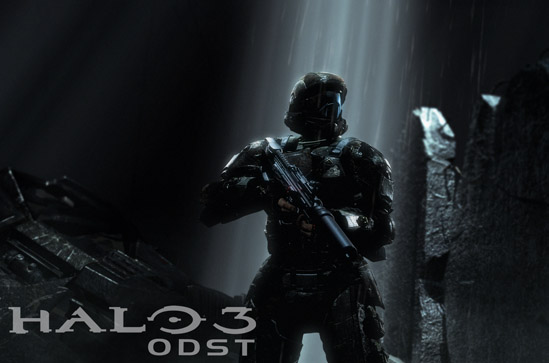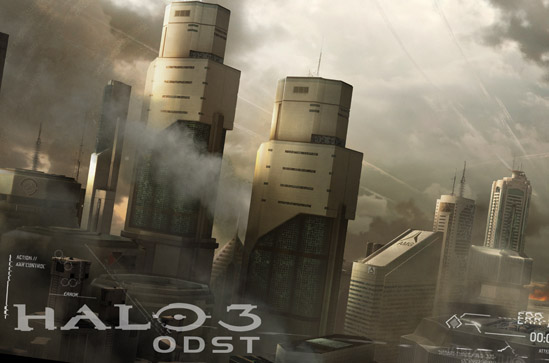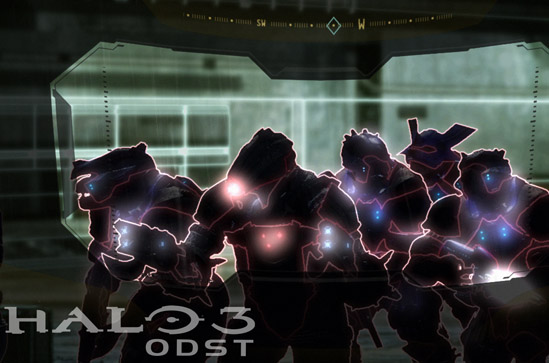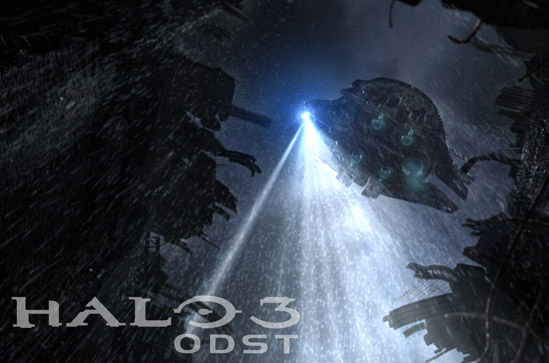Halo 3: ODST: Review
Reviewed by: TJ & MattThe year is 2552. Covenant forces control the city of New Mombasa. They are searching for something beneath its darkened streets. You are an Orbital Drop Shock Trooper. Your orders: Stay alive, meet up with your scattered squad, and escape the embattled city.
About our Consumer section
This section provides a comprehensive review of everything that you need to know about each video game we have reviewed. We’ve thought about everything a gamer needs to know before making a purchase: Is the game too difficult? Does it have good graphics and sound? A solid story-line? Can you play it with your buddies and are the controls so hard that a cyborg would struggle with them? We all know how tough it is to find an awesome game and we hope that this review will help.
Challenge
We found Halo 3 ODST slightly more difficult than its predecessor, but largely consistent with previous versions of the series in that any particular mission or battle, even on your proper difficulty level, could take several tries and slow your progress down. The difficulty is increased by the infrequency of checkpoints, coupled with long, drawn out battles. Also, there are no real major changes in difficulty throughout the game, so as your skill level rises, you will begin to plow through enemies with a little too much ease.
Graphics
The graphics are mainly unchanged from Halo 3. They have the same clarity and vividness, but they also have the same rigidity. Graphics in the Halo games have always been good and still are, but they are not quite on par with some of the competition. The graphics are very vivid and interesting, but seem to lack those little details that make the game seem realistic.
Replay Value
Although the world of ODST is much more open and explorable than previous Halo games, there is really not much reason to go back through it again. There are just about zero side quests, unlockables, or any other secrets to uncover by going back through. The only motivation you might have to play this campaign again is simply to beat it on a higher difficulty level. However, the multiplayer provides for great replay value. The multiplayer is exactly the same as in Halo 3, which is a major plus, as Halo 3's multiplayer is very in depth and well put together. Also, a new game mode has been added for ODST, called “Firefight”. This is a more arcade style game mode, with enemies coming in waves and getting progressively harder. The single player campaign is too linear to merit replay, but, if you like multiplayer, you are guaranteed to keep coming back to ODST.
Narrative
The narrative serves to create a breath of fresh air from the normal routine of the Halo series. The new exploration of a city while trying to find your squad mates gives the storyline of the halo an entirely new feel while exploring the city of New Mombossa. However, as the player switches characters, the story line reverts back to the same style of plowing through enemies to a checkpoint that we see in the previous Halo games. The story more or less works in motivating the player to finish the game, but tended to be fairly anti-climactic. The story is interesting while playing the game, but will fail to truly satisfy the player with closure after finishing the last level.
Ease of controls
If you are new to the Halo series, you might get lost for a bit because the game really doesn't outline the basic controls. Fortunately, the controls are relatively intuitive, so although it might take some time and frustration figuring things out, eventually you will know what you're doing. However, if you have played a Halo game before, the controls will come very easy to you, and the new controls are presented very well.
Social Playability
The main social element of this game comes from online play with the well-known Halo multiplayer, which has always been excellent. The new Firefight mode also adds an extra social element, with the ability to play co-op with up to 3 friends.
Overall grade: B-
All in all, ODST is an interesting addition to the Halo series, adding a new campaign with new characters, but with the same multiplayer that has made the Halo series so successful. The new Firefight mode is a great addition as it provides for much more interesting co-op play. That, combined with the multiplayer are what is great about this game, but the storyline and the often frustrating challenge levels hold it back. What ODST lacks in single player, it makes up for in multiplayer. So, this game is great for the more competitive gamer.
About our Parent section
Parents, we understand the problems you have with video games. Some are violent, inappropriate, and most just cost a lot of money. Fortunately, we understand that these are legitimate concerns and have therefore included in our review a few things that parents need to know about a video game: the amount of violence it has, sexually suggestive material, gender stereotyping, bad language, addictiveness and replay value. We have included all the criteria for a money-worthy and appropriate purchase for your children. We hope you find our evaluations helpful.
Replay Value
Halo 3 ODST has great multiplayer, and if your child enjoys playing online they will keep coming back to it and make the game well worth your money. One thing to be wary of, however, is that the game lacks good replay value in single-player. So if your child is not subscribed to Xbox Live, he or she will likely be done with the game after they beat the game for the first time. To get good value out of this game for your child, you are going to have to spend the extra eight dollars per month for Xbox Live, if you haven't done so already.
Social Playability
If your child played and enjoyed Halo 3 with friends, they will enjoy ODST even more. The addition of the new level-based Firefight mode will allow more potential for “video game get-together” nights where your child and their friends can all get together and compete cooperatively. Another benefit to ODST along with any Halo game is that the game mechanics make it very accessible to novice players, so it will be enjoyed by all.
Objectionable Content
ODST, like all previous Halo games, is certainly violent, but the violence really is not that bad in nature. Sure, the game has you using guns to kill enemies, but the guns are futuristic and somewhat cartoon-like, and the enemies are all alien, never human. There is profanity in the game, but it really does not go anywhere past “hell” and “damn”, words children could easily hear on the nightly news. Halo games really are not nearly as objectionable as their “M” rating shows.
Addictiveness
The campaign in this game will certainly not be addictive, as there are no real side quests or extensive other goals. The multiplayer, much like any other multiplayer game, has potential to be addictive. The pursuit of new and higher rankings may frustrate your child and cause them to keep coming back to the game a little too much, but in that sense ODST is really no better or worse than any other multiplayer game.
About our Academic section
In our dealings with video games, we have also explored the academic research on the topic. We understand the roles that presence, narrative, and even aggression have and we also understand that certain video games might influence learning, gamers’ social interaction, stereotyping and sexual messaging. We have included in our review this section for those interested on the academic perspective of video games and how certain game characteristics can affect video game players.
Academic Perspective
This game is a prime example of a game with violence against aliens as opposed to humans. As some studies have shown, non-human violence leads to less aggression in players than when a game contains aggression against humans, as this game would likely demonstrate. In addition, ODST is likely to allow players to experience more presence (perceptions of non-mediation) than previous Halo games. ODST takes place in a very vast and open-ended environment, so the players have more control over the game and their character's actions. According to the theory of stimulus-arrangement, people naturally want to affect their environment and change it. ODST fulfills this need much more than previous Halo games.
Tagged as:
Available for:Xbox 360




December 25th, 2009 at 10:32 am
The game is frustrating beyond belief due to the constant search for beacons and the lack of progress to a new (different) level. Repitition ad nauseum for what? Another visit to a lake. Goodbye, Halo!